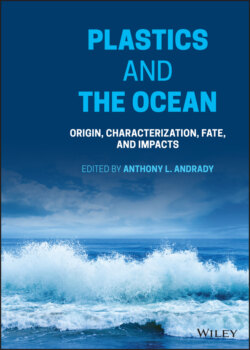Читать книгу Plastics and the Ocean - Группа авторов - Страница 50
2.3.1 The Simple Release of Additives From Plastics to Water
ОглавлениеSince additives are not covalently bound to the polymer, they can migrate from plastic into surrounding environments (Bieber et al. 1984; Garde et al. 1998; Yagoubi et al. 1993). The leaching of plastic additives can be described in four major steps: (i) diffusion of the chemical through the polymer matrix, (ii) desorption of the chemical from the polymer surface, (iii) sorption of the compound at the polymer–water/biota/sediment interface, and (iv) absorption of the compound into the surrounding environment (Bhunia et al. 2013). Step 1, the mass diffusion process, is the rate‐limiting step and governed by Fick’s second law.
The diffusion rate is influenced by MW, concentration, and solubility of the additive in the plastic matrix, as well as the thickness and the fractional crystallinity of the plastic material (Hansen et al. 2013). Small molecules with low boiling point, such as residual monomers, migrate quickly through plastic materials, whereas larger additive molecules migrate more slowly. This has led to the innovative design of larger molecules for use as antioxidants, FRs, and plasticizers to slow down their migration and leaching. Good solubility of the additive in the plastic leads to stronger physical interactions with the polymer chains and therefore a lower propensity to leach out. Therefore, formulators aim to use hydrophobic additives with low water solubility. Plastic additives migrate almost exclusively through the amorphous phase of a polymer matrix and will leach much faster from amorphous polymers (e.g. PS) than crystalline polymers (e.g. high‐density polyethylene [HDPE]). In fact, this has been demonstrated in HDPE systems with varying degrees of crystallinity (Teuten et al. 2009). Another example is organotin heat stabilizers that are more readily released from flexible polymers than from rigid ones (Teuten et al. 2009).
Steps 2 through 4, or the migration of additives at the plastic–seawater boundary, are mainly determined by the partition coefficient between plastic and water (K pw; Endo et al. 2013). Additives with higher K pw (more hydrophobic) will leach slower because they diffuse away from the polymer–water interface toward the plastic core. Despite its importance, K pw values for most additives in common plastics have not been measured or reported. Fortunately, the water solubility and octanol−water partition coefficient (K ow) can be used as chemical properties to estimate the leaching kinetics of plastic additives in seawater (also see Chapter 9). Table 2.5 provides these properties for a list of additives commonly identified in the marine environment.
Leaching of additives into seawater is strongly influenced by environmental conditions, such as temperature, sunlight, and salinity (Reimann et al. 2012; Westerhoff et al. 2008; Zaki and Shoeib 2018). Several studies show the leaching kinetics of common additives (Fikarova et al. 2019; Kedzierski et al. 2018; Koelmans et al. 2014) and even residual monomers (Koelmans et al. 2014; Tian et al. 2020) from plastics into seawater to be highly dependent on additive type, environmental conditions, and the host polymer. High temperatures can accelerate the diffusion of chemicals in polymers leading to greater leaching from plastics in warmer climates (Joo et al. 2004).
Photo‐oxidation leads to dramatic changes in the plastic surface structure, such as increased crystallinity, changes in chemical properties, and cracking which perpetuates fragmentation (Gewert et al. 2015; ter Halle et al. 2017). Fragmentation increases the surface area‐to‐volume ratio, accelerating plastic additive leaching. Likewise, styrene is released at higher rates upon degradation of PS in aquatic conditions (Date et al. 2002; Kwon et al. 2014), as are bisphenol A (BPA) and isocyanates from polycarbonate (PC) and PU, respectively (Biles et al. 1997; Kubwabo et al. 2009). Furthermore, BFR release rates greatly increase from PE as it degrades, and the process is even more accelerated by the actions of digestive fluid once the plastic is ingested by organisms (Sun et al. 2019). Field evidence of enhanced additive leaching with increased fragmentation was demonstrated, in which levels of UV stabilizers were lower in “small” versus “large” plastic fragments collected from the same beach (Tanaka et al. 2020).
Additive concentrations measured in collected marine debris are typically lower than the target loadings in original plastic formulations (Table 2.1), indicating that some degree of leaching into seawater has occurred (Hermabessiere et al. 2017). Tanaka et al. (2020) found that concentrations of UV stabilizers in large plastic fragments were within the range of typical loadings. These results indicate that some additives are sufficiently stable in the polymer even after being fragmented or exposed to harsh conditions. Diffusion of additives from within plastics is rate limiting, and is why phase equilibrium between plastic and water may not be attained in marine conditions (Kwon et al. 2017). Recently, evidence of this was provided in highly weathered and fragmented PE marine debris (Tanaka et al. 2020). Lower concentrations of UV stabilizers were measured in the surface layers of these fragments compared to the inner core.
